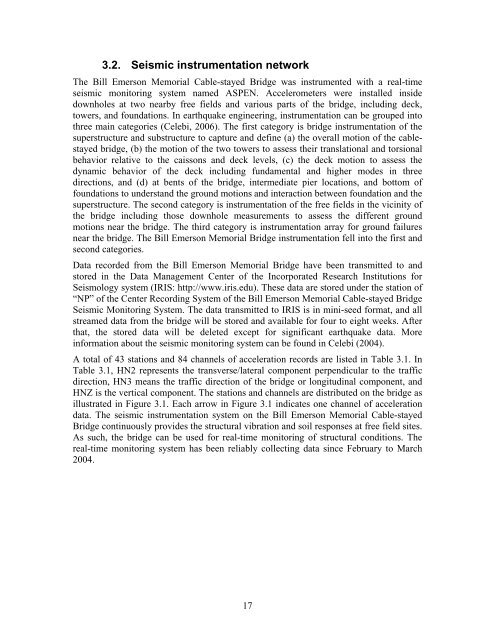Assessment of the Bill Emerson Memorial Bridge - FTP Directory ...
Assessment of the Bill Emerson Memorial Bridge - FTP Directory ...
Assessment of the Bill Emerson Memorial Bridge - FTP Directory ...
- No tags were found...
Create successful ePaper yourself
Turn your PDF publications into a flip-book with our unique Google optimized e-Paper software.
3.2. Seismic instrumentation networkThe <strong>Bill</strong> <strong>Emerson</strong> <strong>Memorial</strong> Cable-stayed <strong>Bridge</strong> was instrumented with a real-timeseismic monitoring system named ASPEN. Accelerometers were installed insidedownholes at two nearby free fields and various parts <strong>of</strong> <strong>the</strong> bridge, including deck,towers, and foundations. In earthquake engineering, instrumentation can be grouped intothree main categories (Celebi, 2006). The first category is bridge instrumentation <strong>of</strong> <strong>the</strong>superstructure and substructure to capture and define (a) <strong>the</strong> overall motion <strong>of</strong> <strong>the</strong> cablestayedbridge, (b) <strong>the</strong> motion <strong>of</strong> <strong>the</strong> two towers to assess <strong>the</strong>ir translational and torsionalbehavior relative to <strong>the</strong> caissons and deck levels, (c) <strong>the</strong> deck motion to assess <strong>the</strong>dynamic behavior <strong>of</strong> <strong>the</strong> deck including fundamental and higher modes in threedirections, and (d) at bents <strong>of</strong> <strong>the</strong> bridge, intermediate pier locations, and bottom <strong>of</strong>foundations to understand <strong>the</strong> ground motions and interaction between foundation and <strong>the</strong>superstructure. The second category is instrumentation <strong>of</strong> <strong>the</strong> free fields in <strong>the</strong> vicinity <strong>of</strong><strong>the</strong> bridge including those downhole measurements to assess <strong>the</strong> different groundmotions near <strong>the</strong> bridge. The third category is instrumentation array for ground failuresnear <strong>the</strong> bridge. The <strong>Bill</strong> <strong>Emerson</strong> <strong>Memorial</strong> <strong>Bridge</strong> instrumentation fell into <strong>the</strong> first andsecond categories.Data recorded from <strong>the</strong> <strong>Bill</strong> <strong>Emerson</strong> <strong>Memorial</strong> <strong>Bridge</strong> have been transmitted to andstored in <strong>the</strong> Data Management Center <strong>of</strong> <strong>the</strong> Incorporated Research Institutions forSeismology system (IRIS: http://www.iris.edu). These data are stored under <strong>the</strong> station <strong>of</strong>“NP” <strong>of</strong> <strong>the</strong> Center Recording System <strong>of</strong> <strong>the</strong> <strong>Bill</strong> <strong>Emerson</strong> <strong>Memorial</strong> Cable-stayed <strong>Bridge</strong>Seismic Monitoring System. The data transmitted to IRIS is in mini-seed format, and allstreamed data from <strong>the</strong> bridge will be stored and available for four to eight weeks. Afterthat, <strong>the</strong> stored data will be deleted except for significant earthquake data. Moreinformation about <strong>the</strong> seismic monitoring system can be found in Celebi (2004).A total <strong>of</strong> 43 stations and 84 channels <strong>of</strong> acceleration records are listed in Table 3.1. InTable 3.1, HN2 represents <strong>the</strong> transverse/lateral component perpendicular to <strong>the</strong> trafficdirection, HN3 means <strong>the</strong> traffic direction <strong>of</strong> <strong>the</strong> bridge or longitudinal component, andHNZ is <strong>the</strong> vertical component. The stations and channels are distributed on <strong>the</strong> bridge asillustrated in Figure 3.1. Each arrow in Figure 3.1 indicates one channel <strong>of</strong> accelerationdata. The seismic instrumentation system on <strong>the</strong> <strong>Bill</strong> <strong>Emerson</strong> <strong>Memorial</strong> Cable-stayed<strong>Bridge</strong> continuously provides <strong>the</strong> structural vibration and soil responses at free field sites.As such, <strong>the</strong> bridge can be used for real-time monitoring <strong>of</strong> structural conditions. Thereal-time monitoring system has been reliably collecting data since February to March2004.17
















